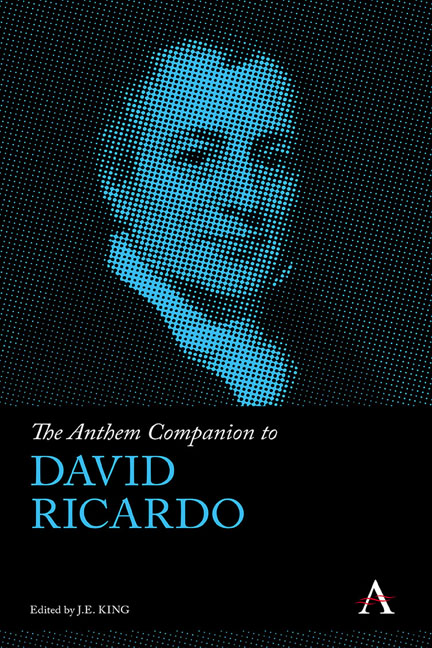Book contents
- Frontmatter
- Contents
- Notes on Contributors
- Chapter 1 Introduction
- Chapter 2 On Some Myths about Ricardo’s Theory of Money
- Chapter 3 Ricardo on Foreign Trade
- Chapter 4 ‘A Tolerably Correct Law Respecting Proportions’: Ricardo on Income Distribution
- Chapter 5 Ricardo on Economic Policy
- Chapter 6 (Mis)Interpreting Ricardo
- Chapter 7 Ricardo’s Business Activities
- Chapter 8 Political Economy ‘Through a Glass Hive’? The Encounter of Ricardian Ideas with Nineteenth-Century Australia
- Chapter 9 Ricardo and Classical Political Economy
- Chapter 10 Ricardo and Marx
- Chapter 11 Malthus and Ricardo on the Dismal Science
- Further Reading
- Index
Chapter 2 - On Some Myths about Ricardo’s Theory of Money
Published online by Cambridge University Press: 17 October 2023
- Frontmatter
- Contents
- Notes on Contributors
- Chapter 1 Introduction
- Chapter 2 On Some Myths about Ricardo’s Theory of Money
- Chapter 3 Ricardo on Foreign Trade
- Chapter 4 ‘A Tolerably Correct Law Respecting Proportions’: Ricardo on Income Distribution
- Chapter 5 Ricardo on Economic Policy
- Chapter 6 (Mis)Interpreting Ricardo
- Chapter 7 Ricardo’s Business Activities
- Chapter 8 Political Economy ‘Through a Glass Hive’? The Encounter of Ricardian Ideas with Nineteenth-Century Australia
- Chapter 9 Ricardo and Classical Political Economy
- Chapter 10 Ricardo and Marx
- Chapter 11 Malthus and Ricardo on the Dismal Science
- Further Reading
- Index
Summary
Introduction
Judging by the Sraffa edition of his Works and Correspondence (Ricardo 1951–73), more than one half of Ricardo's writings was devoted to money. However, many commentators in this domain only consider his early publications, what Sraffa called his ‘Bullion Essays’ of 1809–11. It is as if Ricardo's turn to the study of value and distribution from 1815 onwards changed nothing in his monetary views or at worst made them more confused. Such an attitude obviously downplays his Proposals for an Economical and Secure Currency (Ricardo 1816) and the monetary aspects of On the Principles of Political Economy, and Taxation, which cannot be reduced to the sole Chapter XXVII ‘On Currency and Banks’. It also neglects many interventions by Ricardo from 1819 until his death in 1823, whether in print, speeches or correspondence. This is not only to be regretted because the ‘Bullion Essays’ were written in the exceptional circumstances of the suspension of convertibility while the later contributions were concerned with the conditions and effects of the return to a normal system of convertible notes. Focusing on the ‘Bullion Essays’ also postulates that Ricardo's theory of money was disconnected from his theory of value and distribution. On the contrary, when in 1815 he shifted from monetary issues to political economy at large, Ricardo was conscious that the understanding of commodity price required coordinating these two theories. To know whether he succeeded in doing so one must assess the logical consistency between them. I will contend that only after 1815 did Ricardo develop a mature theory of money, both specific and coherent.
Failing to take account of the whole of Ricardo's writings on money has nourished some myths about his monetary theory. Indeed, myths have been common for long in the literature on his other theories, but nowhere are they more frequent than on money. Just to mention a few: most of Ricardo's economics is concerned with a non-monetary economy (barter); Ricardo held a commodity-theory of money (money is gold); he also held a strict quantity theory of money (in which the general level of prices varies proportionally with the quantity of money); according to him paper money (banknotes) behaves like metallic money, with its quantity adjusting automatically thanks to convertibility and international gold flows; his precept for the issuing bank was to maintain a 100 per cent proportionality between issues and metallic reserves.
- Type
- Chapter
- Information
- The Anthem Companion to David Ricardo , pp. 9 - 28Publisher: Anthem PressPrint publication year: 2023



